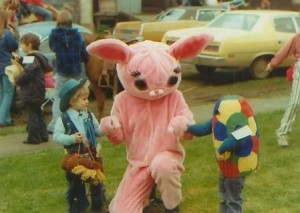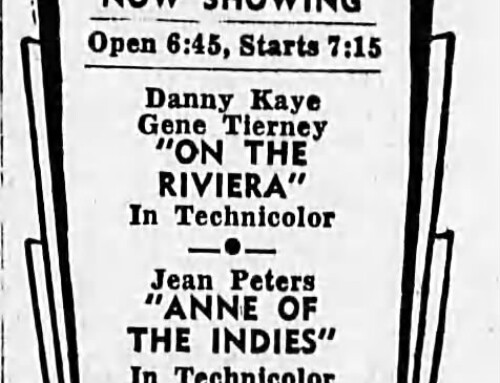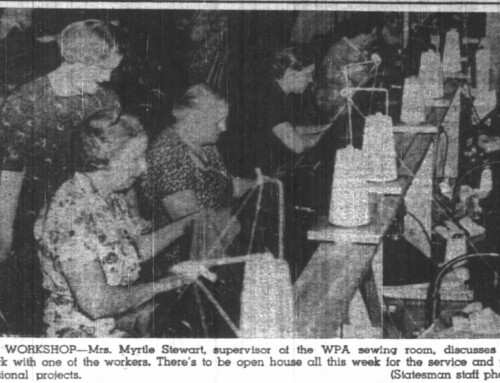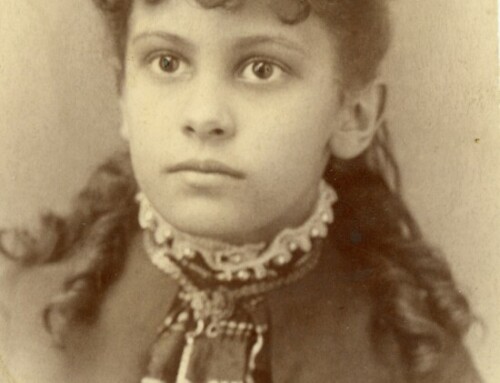
Cowboy Jeff Bright, Bunny Dean Davis, and Egg Michael Linger at the 1976 Donald Easter Parade. Willamette Heritage Center 2004.025.0028
“Here comes Peter Cottontail hopping down the bunny trail. Hippity-hoppity Easter’s on its way!”
My favorite group of Easter-themed items in the collection of the Willamette Heritage Center are a series of photographs from an Easter parade in Donald, Oregon in 1976. The Easter bunny all in pink, bends down to speak with a little cowboy and Easter egg. A Bluebird group (Campfire Girls) stands in formation ready to carry the official banner and lead the parade. Boys in costumes and girls dressed up in their Easter outfits of ruffled dresses, gloves and bonnets. The excitement on their faces comes through the generations.
Perhaps it’s a bit nostalgic, but for a child raised on Rankin-Bass stop motion animated films like Peter Cottontail and The Easter Bunny is Comin’ to Town, with a mother that sewed matching Easter outfits for her 5 children and a father that brought home live chicks from the family farm it’s easy to get caught up in the excitement of the children of Donald marching in parade. I searched through online newspapers and additional items in our collection from the Donald History Museum looking for more information about the Easter parade. Was it a annual event? Something the children of the community looked forward to and community groups planned for? I hit a dead-end. Hopefully some of our readers will reach out and provide some answers to my questions.
It got me thinking however. What annual events did the children of Salem look forward to at Easter time?. I found historic newspaper accounts as early as the 1890s announcing Easter services at local churches. Inter-denominational sunrise services also seemed to be an on-going tradition. At first rotating amongst churches, then for a time at Belcrest Memorial Cemetery, and then at McCullough Stadium where the venue could accommodate the growing crowds.
Easter was also a huge marketing opportunity for local merchants that catered to women and children. Often playing off the theme of the 1948 film Easter Parade with Fred Astaire and Judy Garland. Even the local society columnists took part, spotlighting a few of the best dressed women and children as they exited church services.
After church, families patronized local restaurants for Easter brunch or if you were from the wealthier set, perhaps your family hosted Easter dinner in your home for family and friends complete with hand-painted Easter eggs for take-home favors such as the Gilbert family.
But let’s get back to the children shall we? New scratchy Easter clothes, church services, and formal Easter dinners would not have made it to the top of my Easter fun list. Continuing my research through online newspapers, an article from April 1950 caught my eye, “Egg Hunt Set for Willson Park”. Organized by the 20-30 club which hoped to make it an annual event, the hunt was for children 9 and under. Parents were requested to accompany their children and bring containers for the eggs. Here was something the children would enjoy.
The 20-30 club was a service club made up of young men in their twenties and thirties that was organized in Salem in 1935. The Salem group was true to their club motto, “a man never stands so tall as when he kneels to help a child” and was actively involved in petitioning for parks, organizing athletic meets, donkey baseball games, even an air circus all to benefit children of the community.
The first year of the Easter egg hunt in Willson Park or the capitol grounds the young men hid 3,000 eggs in the shrubbery. The paper later reported that the kids in their eagerness “did some violence to the shrubbery” and “suggestions were heard that the event be transferred to a spot next year where shrubbery planted for landscaping purposes won’t be endangered.” Despite objections, the hunt became an annual tradition at Willson Park until 1957 when it was moved to Bush Park. By that point, the club was hiding 12,000 eggs and had modified the rules dividing the kids up into two groups. The trotters, age 2-8 years old and the sprinters, ages 9-12. The hunt continued to evolve as the group sought to keep kids safe during the fun. By its last year in 1988 about 1200 children participated despite the rainy weather. 12,000 cellophane wrapped gum-drop eggs were hidden in the park. The most prized eggs wrapped in colored electrician’s tape, could win the finder one of more than $500 worth of prizes donated by area merchants.
Here’s to a happy Easter for the children of our community from the Willamette Heritage Center. If you’re curious to see a few more of the Donald Easter Parade photos visit our blog at : https://www.willametteheritage.org/donald-easter-parade-1977/
This article was written by Kaylyn F. Mabey for the Statesman Journal where it was printed 16 April 2017. It is reproduced here with sources for reference purposes.
Sources:
- “Tots and Worshipers in Easter Festivities” Daily Capital Journal (Salem, OR), April 10, 1950, p. 1
- “Egg Hunt Set at Willson Park” Statesman Journal (Salem, OR), April 7, 1950, p. 1
- “Community Easter Egg Hunt Planned by Club” Statesman Journal (Salem, OR), March 29, 1950, p. 2
- “Easter Egg Hunt Due at Willson Park” Daily Capital Journal (Salem, OR), March 30, 1950, p. 1
- “Club to Scatter 24,000 Eggs” Statesman Journal (Salem, OR), April 6, 196, p. 1
- “Rain Fails to Dampen Easter Spirit in Salem” Daily Capital Journal (Salem, OR) April 14, 1952, p. 4
- “Easter Egg Hunt Planned Sunday at Willson Park” Statesman Journal (Salem, OR), April 2, 1953, p. 1
- “Easter Egg Hunt at State House” Daily Capital Journal (Salem, OR), April 6, 1950, p. 2






